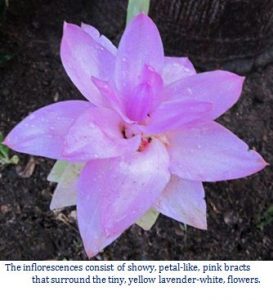By Tommy Clarkson from the July 2016 Edition
Family: Zingiberaceae
Also known as: None
The genus Curcuma consists of between ten to one hundred different species (professional opinions,  obviously, widely vary) in the ginger family (Zingiberaceae) which also contains the Tumeric plant (Curcuma longa). All originated in south to southeast Asia.
obviously, widely vary) in the ginger family (Zingiberaceae) which also contains the Tumeric plant (Curcuma longa). All originated in south to southeast Asia.
Now, not to get sidetracked early, but this is good to know stuff that can prepare you for a successful stint on the TV Show Jeopardy or enhance your competitiveness, at home, playing Trivial Pursuit!
Turmeric is, of course, the key ingredient in curry powder. However, beyond that, it is called by some “the healthiest spice on earth”. Derived from the dried, then ground, Tumeric root, it has been used by Indian Ayurvedic healers (one of the world’s oldest nature healing systems) for centuries.
However, much more recently, the scientific community has been evaluating it as a potential natural remedy for medical conditions like as varied as allergies, Alzheimer’s disease, cancer, cardiovascular disease, cataracts, cognitive decline, Crohn’s disease, and ulcerative colitis.
 The reason I share that information is that the Curcuma phaeocaulis has some good stuff going for it as well! Not only is it a commonly prescribed Chinese
The reason I share that information is that the Curcuma phaeocaulis has some good stuff going for it as well! Not only is it a commonly prescribed Chinese
medical herb for tumor therapy but significant research has been going on regarding the “Anti-tumor potential of ethanol extract of Curcuma phaeocaulis ‘Valeton’ against breast cancer cells”.
But this all is supposed to be more about tropical botanical than pharmaceutical information, right? So scant though the gardening information on this beauty may be let’s discuss what I have experienced with mine “up close and personal” as well as whatever I have dug up from reading about it in my books.
Where and how I acquired my Curcuma phaeocaulis specimens is quite the story particularly if one recalls the origin of them on the other side of the world! It all commenced when my best pal, Rowdy, and I were exploring back areas a couple of hours outside of Manzanillo around the tiny community of La Rosa.
We’d stopped to admire two varieties of giant Agave that were different from my several types already  growing in Ola Brisa Gardens. Well, one thing led to another and before we know it we’d acquired a couple of new buddies, were having tequila with them and wandering around the area admiring their numerous different plants!
growing in Ola Brisa Gardens. Well, one thing led to another and before we know it we’d acquired a couple of new buddies, were having tequila with them and wandering around the area admiring their numerous different plants!
During these meanderings, we came across perhaps thirty or forty of these stunners growing beneath several bananas. Almost immediately, several of these beauties started begging to come home with me, so what could we do but comply with their pathetic and plaintive little plant pleadings!
Besides these and the Agave, before the trip was over, we’d picked up two other new tropical flowers and a seed to plant from an unidentified but delicious small, yellow, tropical fruit we’d never encountered before!
While mine is still growing, research has borne out that this magnificent, rhizomatous tropical perennial can that grow up to two feet (.3 meters) tall and have a spread of one to two feet. (.3 -.6 meters).
It is a repeat bloomer during the spring and summer season in our environs with the plants going dormant in late fall and winter. (As in all our garden’s beds we mulch them, copiously, with coconut coir (fiber).
What at first are perceived as the flowers are actually bracts. These inflorescences each of around three inches in height consist of showy, petal-like, pink bracts that surround the tiny, yellow lavender white, true flowers. The true flowers are seen only if they curl around the bracts edges. Each inflorescence appears atop a rigid, reed like stem that grows to two inches (five cm) tall from a clump of narrow, lance shaped, dark green leaves.
To the best of my awareness, they have no serious insect or disease problems. Water them well probably a couple of times a week but let the soil dry out a bit between those sessions. As to fertilizer, I’d suggest use of a general flower and plant type monthly something as simple as Miracle Gro while they are flowering.
From what I have experienced, and been able to determine firsthand, these plants can grow in a variety of environments. But if they have their “druthers” they’d prefer bright filtered light, high humidity and well draining, fertile soil. Propagation I learned from the outset out in the country is by root division.
An added bonus is that those magnificent flowers are longlasting when cut and really add to a tropical floral arrangement.
Download the full edition or view it online
—
Tommy Clarkson is a bit of a renaissance man. He’s lived and worked in locales as disparate as the 1.2 square mile island of Kwajalein to war-torn Iraq, from aboard he and Patty’s boat berthed out of Sea Bright, NJ to Thailand, Germany, Hawaii and Viet Nam; He’s taught classes and courses on creative writing and mass communications from the elementary grades to graduate level; He’s spoken to a wide array of meetings, conferences and assemblages on topics as varied as Buddhism, strategic marketing and tropical plants; In the latter category he and Patty’s recently book, “The Civilized Jungle” – written for the lay gardener – has been heralded as “the best tropical plant book in the last ten years”; And, according to Trip Advisor, their spectacular tropical creation – Ola Brisa Gardens – is the “Number One Tour destination in Manzanillo”.




